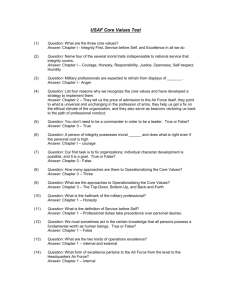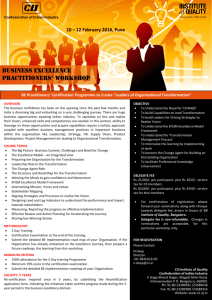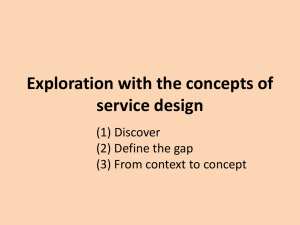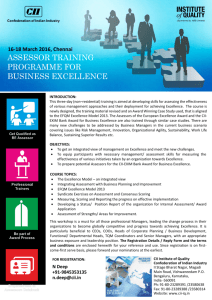business excellence journey in countries in transition
advertisement
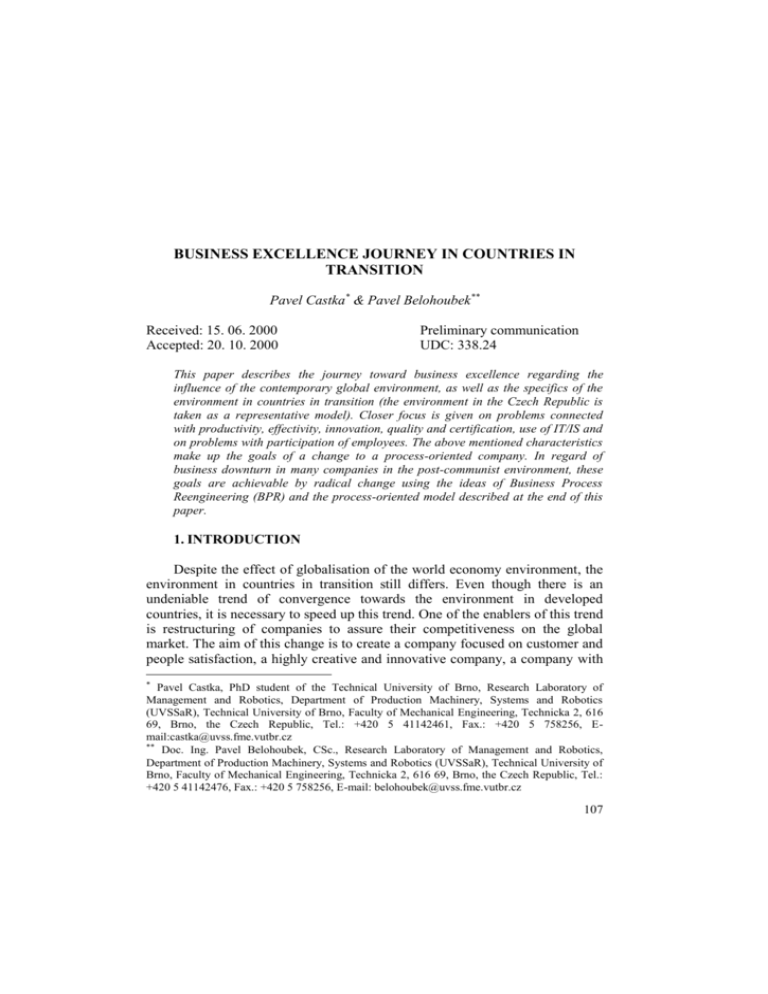
BUSINESS EXCELLENCE JOURNEY IN COUNTRIES IN TRANSITION Pavel Castka* & Pavel Belohoubek** Received: 15. 06. 2000 Accepted: 20. 10. 2000 Preliminary communication UDC: 338.24 This paper describes the journey toward business excellence regarding the influence of the contemporary global environment, as well as the specifics of the environment in countries in transition (the environment in the Czech Republic is taken as a representative model). Closer focus is given on problems connected with productivity, effectivity, innovation, quality and certification, use of IT/IS and on problems with participation of employees. The above mentioned characteristics make up the goals of a change to a process-oriented company. In regard of business downturn in many companies in the post-communist environment, these goals are achievable by radical change using the ideas of Business Process Reengineering (BPR) and the process-oriented model described at the end of this paper. 1. INTRODUCTION Despite the effect of globalisation of the world economy environment, the environment in countries in transition still differs. Even though there is an undeniable trend of convergence towards the environment in developed countries, it is necessary to speed up this trend. One of the enablers of this trend is restructuring of companies to assure their competitiveness on the global market. The aim of this change is to create a company focused on customer and people satisfaction, a highly creative and innovative company, a company with * Pavel Castka, PhD student of the Technical University of Brno, Research Laboratory of Management and Robotics, Department of Production Machinery, Systems and Robotics (UVSSaR), Technical University of Brno, Faculty of Mechanical Engineering, Technicka 2, 616 69, Brno, the Czech Republic, Tel.: +420 5 41142461, Fax.: +420 5 758256, Email:castka@uvss.fme.vutbr.cz ** Doc. Ing. Pavel Belohoubek, CSc., Research Laboratory of Management and Robotics, Department of Production Machinery, Systems and Robotics (UVSSaR), Technical University of Brno, Faculty of Mechanical Engineering, Technicka 2, 616 69, Brno, the Czech Republic, Tel.: +420 5 41142476, Fax.: +420 5 758256, E-mail: belohoubek@uvss.fme.vutbr.cz 107 Management, Vol. 6, 2001, 1-2, pp. 107-117 P. Castka, P. Belohoubek: Business excellence journey in countries in transition a high level of productivity and quality. Such a change is a difficult aim in whatever environment, but even more difficult in the environment of postcommunist countries. This is especially due to the bureaucratic culture, low level of business ethics and the unstability of the political and economic environment. 2. ANALYSIS OF THE ENVIRONMENT IN COUNTRIES IN TRANSITION According to several studies, the world of business in the next century will be global, turbulent, sophisticated, dynamic, ecologic and connected by networks. In the table below (Table 1), some crucial features are mentioned which can be traced among the previously mentioned aspects of contemporary environment. Coincidentally, it gives some examples of impacts of these features. Table 1: Crucial features of contemporary environment MAIN FEATURES EXAMPLES OF IMPACTS Information Internationalisation amalgamation global companies global market searching for similarities and wider contexts from different branches benchmarking of activities job rotation participation in decision-making emphasis on individual work deputising of authority to employees Interdisciplinary approach Individualisation and humanisation reduction of bureaucracy acceleration of processes and changes simplified sharing of information and its up-dating escalating level of information possessed by employees and, consequently, escalating level of their motivation The most innovative companies are changing their philosophies now in order to ensure future competitiveness. In the Czech Republic, on the other hand, most companies embody characteristics such as inflexibility, inconsistent focus on the customer, functional instead of a process orientation approach, low 108 Management, Vol. 6, 2001, 1-2, pp. 107-117 P. Castka, P. Belohoubek: Business excellence journey in countries in transition level of innovation potential, bureaucratic culture, high indirect costs, low productivity, high quality costs, obsolete equipment, etc. 3. GOALS OF A CHANGE The process of change has to be directed in order to ensure the process orientation, customer and people orientation and has to set up the basis of strong company culture. The lack of these factors proves the below mentioned results of the research (section 3.1). Such a change is in competence of top management. Top management, thus, should take all necessary actions to ensure the fulfilment of these goals. Nevertheless, we cannot blame top management for all these problems. In most cases, it is the non-standard environment that faces down the changes. There is still a lot of state-owned-monopolistic companies which make possible the strong influence of lobby groups, a great amount of corruption, no responsibility and this environment does not provide the necessary independence of management on its owners. The successful and competitive company should fulfill the following elements: high productivity and effectiveness, high innovative potential, high quality of all processes and products, intelligent use of information technology and participation of all employees. 3.1. High productivity and effectiveness According to the research of CZIPIN & Partner, a company from Austria, 49% (on average) of the working time in the Czech Republic is unproductive. The highest rate, then, hits upon the organisation of work and planning (33%), use of IS/IT (18%) and morale (15%) – see Figure 1. 6 7% 5 13% 1. 1 33% 2. 3. 4. 5. 4 14% 3 15% 2 18% 6. Organisation of Work and Planning Use of IS/IT Morale Communication Management and Control Activities Training Figure 1. Unproductive time due to the different factors 109 Management, Vol. 6, 2001, 1-2, pp. 107-117 P. Castka, P. Belohoubek: Business excellence journey in countries in transition The results of this research prove that the process approach orientation is still not widespread and that due to that fact, almost half the time is spent in an unproductive way. Consequently, it highlights another important aspect of successful companies: the importance of the human factor for productivity. 3.2. High innovative potential Innovation of products and processes is a crucial factor for competitiveness of enterprises. The result of the innovative process is a new product and/or a new service with an added value and this process is the only possibility to assure the dynamic development of a company. Important features for a highly innovative company are company culture and level of communication. The former should create a creative environment, i.e. an environment which tolerates a certain amount of mistakes and enables the employees to actuate new ideas in practice. The latter, then, is the key element of the speed-up of new ideas (with all features mentioned in Table 1). Such a culture will set up the permanent innovative culture. The management of an innovative process depends on the basic laws of innovations. For instance, a certain level of low-level innovations will end up in the innovation of a higher level and the contrary. If we create a creative environment (mentioned above), a great amount of low-level innovations will evoke the necessity of innovation of a higher level. This approach (if continuously repeated) can end up in a continuously accelerated process of innovation (Belohoubek, 1997). 3.3. High quality of all processes and products Nobody can impeach the target of high quality in a company. The thing to be impeached is the other problem connected with quality systems: certification. In the last quarter of the century, the ISO 9000 quality system has been used to verify the status of a company and this certification declares that the requirements (according to ISO 9000 standards) are met. Here, we come to the core of the problem: are these requirements objective? Would it not be better to compare with the best in the class? Moreover, “there is a lack of research that can shed light on whether companies that are certified to the ISO 9000 standards actually produce better products than companies that have not been certified” (Juran, 1999). The year 2000 brought the complete revision of the ISO 9000 family. The prior 20 chapters of ISO 9001 were transformed into a process oriented model. 110 Management, Vol. 6, 2001, 1-2, pp. 107-117 P. Castka, P. Belohoubek: Business excellence journey in countries in transition A number of standards were reduced from more than 20 standards to three standards only: ISO 9000 (Concepts and vocabulary), ISO 9001 (Requirements) and ISO 9004 (Guidelines). The revised version comes with a greater orientation towards continuous improvement, customer satisfaction, and compatibility with other management systems (such as ISO 14000 for Environmental Management). Nevertheless, the main problems remained: ISO 9000 is high-priced and brings expansion of bureaucracy. These are the greatest problems especially for the companies in transition. ENABLERS RESULTS PEOPLE RESULTS PEOPLE LEADER-SHIP POLICY & STRATEGY PROCESSES CUSTOMER RESULTS KEY PERFOR-MANCE RESULTS PARTNER -SHIPS & RESOURCES SOCIETY RESULTS RESULTS INNOVATIONS AND LEARNING Figure 2. The EFQM Excellence Model A substitutional approach represents a model defined by the European Foundation for Quality Management (EFQM). “The EFQM Excellence Model is a non-prescriptive framework” (EFQM, 1999) that provides the approach to achieving sustainable organisational excellence. The model consists of nine criteria, which are divided into two main groups (Figure 2): enablers and results. The former evaluates how the results are reached, while the latter evaluates what a company has already fulfilled. The maximum score is 1000 points. The great advantage while using this model is the possibility to compare (in regard to Benchmarking philosophy) the results with the best and the expenses for self-assessment are not very high. Despite these advantages, companies from countries in transition are still not involved in these activities 111 Management, Vol. 6, 2001, 1-2, pp. 107-117 P. Castka, P. Belohoubek: Business excellence journey in countries in transition (for instance, among the members of EFQM there are only four organisations from the Czech Republic). 3.4. Intelligent use of information technology Information technologies (IT) provide a new dimension for management and the whole organisation as well (see Table 1). This fact is beyond dispute but the use of IT still brings problems. It is necessary to look at IT within the reengineering philosophy and to assure first the correct process orientation of a company and then to apply IT. On top of that, IT should be viewed not only as an instrument for improvement of current activities, but also as an opportunity for unknown possibilities. For instance, shared databases, expert systems, online documents, decision support tools, etc. 3.5. Participation of all employees If we want to study the roots of participation philosophy, we have to look back to the ‘50s when the principles of Japanese management philosophy, known as “Ningen Sho” (Respect for the People), were created. According to this approach, the human aspect was taken as a crucial factor for success. High productivity, high quality, mutual co-operation between workers and management and equal division of the result of business became the main trends in management. The most outstanding characteristics that claimed the phenomenal growth in Japan are said to be the following: career employment, seniority principle and company-based trade unions. Even if these main features are changing in the last few years and career employment or seniority systems are replaced, its influence and asset on management style is indisputable. In fact, these systems do not mean an instrument anymore but rather a long-term approach: to assure a low level of fluctuation in the company and participation of all employees. Low fluctuation enables investment of the training of employees because this approach assures that this investment will be valorised in the future. At the same time, long-term employment creates a tighter relation between the company and its employees, increases employee loyalty toward the company and increases knowledge of the company as a whole (for instance, within the philosophy of job rotation). 112 Management, Vol. 6, 2001, 1-2, pp. 107-117 P. Castka, P. Belohoubek: Business excellence journey in countries in transition The bearing idea of philosophy Ningen Sho is the idea of participation, i.e. participation in decision-making and responsibilities. The decision-making system is called “Ringi Sei”(decision-making by consensus). Under this system, any changes in procedures and routines are originated and influenced by those who are directly concerned with these changes. A final decision is made at the top level, but this system enables all employees to participate in the company decision-making process and, at the same time, serves as a communication and information tool. Even though this system was criticised due to its idleness, it is not a sufficient argument while using modern IT/IS technologies. Responsibility for decision-making goes hand in hand with participation in such a decision. Due to this fact, the system of decision-making has to describe also the personnel responsible and set down the rate of responsibility for other persons involved. 4. APPROACH TO CHANGE MANAGEMENT In section 2, the aims of change were defined. More specific (and difficult) is the process of change itself. There exist two extreme approaches to change management: the revolutionary one and the evolutionary one. While the former is fundamental, radical, fast, top-down oriented and socially incompatible, the latter is a continuous, long-term procedure with high social compatibility. Both approaches have their strengths and weaknesses. Business Process Reengineering (BPR) is the example of a radical approach to change management. BPR means the change of the philosophy of engineering activities and (on this basis) the fundamental re-thinking and radical re-design of business processes to achieve dramatic improvements in critical, contemporary measures of performance, such as cost, quality, service and speed, with critical orientation on processes, which are useful for the customer. This approach emphasises especially process and customer orientation and the intelligent use of information technologies. On the other hand, Organisational Development (OD) represents the contrary philosophy. The OD approach is based on the re-design of the organisational structures and on the change of behaviour of employees. Its target is to improve productivity and organisation culture at the same time. The change is of long-term character (continuous improvement) and the emphasis is given to the social aspect. The above mentioned research of productivity (section 3.1) emphasises the dominant problems connected with organisation of work and with the use of IT. 113 Management, Vol. 6, 2001, 1-2, pp. 107-117 P. Castka, P. Belohoubek: Business excellence journey in countries in transition Furthermore, if we take into consideration the liquidity and/or result crisis in most companies, an application of BPR (on the most ineffective processes) is necessary. The problem of BPR is its low rate of successful implementation. This is due to bad methodology of implementation, weak support of top management, resistance against change and lack of training. Especially the resistance of organisation is quite high in many post-communist companies. However, successful implementation is possible and brings relatively fast and positive changes. To ensure this, BPR implementation must be customer oriented, take advantage from the experience of successful companies, be oriented to the future and must be based on the training of relevant personnel. 5. A NEW COMPANY MODEL FOR A TURBULENT ENVIRONMENT In consequence of problems discussed in previous sections and in view of the situation in the Czech companies, it is necessary to use the optimalisation of the above mentioned conceptions, criteria and methods to assure: 1. right product, 2. right market, 3. right company structure, 4. right management and 5. right use of sources. Figure 3, given below, shows the proposal of a New Company Model for A Turbulent Environment. To go with the above, this model is based on process orientation, benchmarking, strategic partnership (amalgamation), integration of suppliers, self-assessment, participation, training, rotation decision-making process, as well as customer and people satisfaction. The key elements of this model are process orientation and participation. The former is based on ISO 9000:2000 process model which defines the main processes in a company and its measurement, analysis and continuous improvement. The latter emphasises the necessity of participation of all employees in the decision-making process (see section 2.5) and responsibility. Both of these approaches require the development of communication systems. 114 Management, Vol. 6, 2001, 1-2, pp. 107-117 P. Castka, P. Belohoubek: Business excellence journey in countries in transition BENEFICIAL SUPPLIER RELATIONSHIP SUPPLIERS TY TRAINING MANAGEMENT RESPONSIBILI PARTICIPATION DEPUTATION Decision Making Process RESOURCE MANAGEMENT CUSTOMERS MARKETS SOCIETY BENCHMARKING MANAGEMENT OF PROCESSES CUSTOMER FOCUSED ORGANISATION CUSTOMER ON GLOBAL MARKET MEASUREMENT, ANALYSIS AND IMPROVEMENT COMMUNICATION, SELF-ASSESSMENT BEST COMPANIES STRATEGIC PARTNERS Figure 3: A New Company Model for A Turbulent Environment 115 Management, Vol. 6, 2001, 1-2, pp. 107-117 P. Castka, P. Belohoubek: Business excellence journey in countries in transition Communication systems and continuous assessment make up the crucial features of this model. The former does not count only the use of IS/IT (as discussed in section 3.4), but also the creating of a communicative company culture based on the idea of participation. The continuous assessment is closely linked with the continuous improvement of all processes in the company, i.e. data should be gathered from all processes, it should be analysed, decisions taken in view of the data and the actions taken. The results of assessment are benchmarked against the best companies and such a comparsion provides relevent information about the quality of process measured. Furthermore, training of all employees is necessary for the understanding of a new environment. To sum up, the inputs of a model discussed consist of requirements of costumers, market and society, as well as of information about the best companies and their performance, information from strategic partners and suppliers. This information makes up the basis for a chain of processes (see Figure 3). Finally, the output is provides to a customer on the global market. REFERENCES: 1. 2. 3. 4. 5. 6. 7. 8. 9. 10. 11. 12. 13. 116 Belohoubek, P., Logistics in Factory Control V – Engineering and Management of Products and Processes, ICB, Brno, 1999. Belohoubek, P., Logistics in Factory Control III – Reengineering, Publication of ICB, Brno, 1997. Castka P.; Belohoubek, P., Systematical Support of Management, The 10 th International DAAAM Symposium, Vienna, 1999. EFQM, Aspects of excellence (European Quality Award 1998), European Quality Publications, 1998. EFQM, The European Foundation for Quality Management, The EFQM Press, 1999. Hammer, M; Champy, J., Reengineering the Corporation: A Manifesto for Business Revolution, Harper Collins Publishers, New York, 1993. Ishikawa, K., What is Total Quality Control ? - The Japanese Way, Prentice Hall, Inc., 1991. Juran, J. M., Juran Urges Research, Quality Progress, July 1999, p.30. Karlöf, B; Östblom, S., Benchmarking, Victoria Publishing, Prag 1995. Marhoulova, D., Japanese System of Management, Institute of Management, Prague, 1991. Matsumoto, K., Participative Management, Grada Publishing, Prague, 1997. Mizutani, E.; Miyai, J.; Inohara, H., Japanese Management Today and Tomorrow, Czech Society for Quality, Prague, 1998. Peters, T. J.; Waterman, R. H., In Search of Excellence, Harper & Row, New York and London, 1981. Management, Vol. 6, 2001, 1-2, pp. 107-117 P. Castka, P. Belohoubek: Business excellence journey in countries in transition 14. Robson, M.; Ullah, P., A Practical Guide to Business Process Reengineering, Gower Publishing Limited, 1996. 15. Scheiber, K., ISO 9000 - The Great Revision, Czech Society for Quality, Prague, 1998. 16. Stitt, J., Managing for Excellence, ASQC Quality Press, 1990. 17. Vytlačil, M.; Mašín, I.; Staněk, M., World Class Business, Institute of Industrial Engineering, Liberec, 1997. PREMA POSLOVNOJ IZVRSNOSTI U ZEMLJAMA U TRANZICIJI Sažetak U ovom se radu opisuje težnja prema poslovnoj izvrsnosti, potaknutoj kako utjecajem suvremene poslovne okoline, tako i specifičnostima okruženja u tranzicijskim zemljama (od kojih je Češka Republika uzeta kao reprezentativni model). S posebnom pozornošću raspravlja se o problemima vezanim uz produktivnost, efektivnost, inovaciju, kvalitet i dobijanje certifikata kvalitete, uporabu informacijske tehnologije i informacijskih sustava, kao i participaciju zaposlenih. Spomenute se karakteristike povezuju s ciljevima promjena usmjerenim prema stvaranju procesno orijentiranog poduzeća. Uzimajući u obzir i poslovne teškoće mnogih poduzeća u post-komunističkom okruženju, smatra se kako je ove ciljeve moguće postići radikalnim organizacijskim promjenama, koristeći ideje reinženjeringa poslovnih procesa (BPR) i procesno orijentiranog modela poduzeća, opisanog u radu. 117 118

